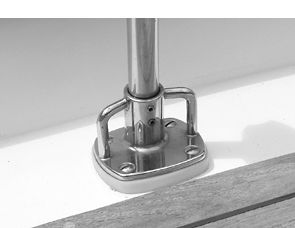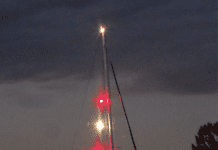Last month we looked at portable safety equipment designed to keep you aboard your boat, or retrieve you if you go overboard. This month, we look at the permanent system which is intended to keep you aboard: the lifelines and rails.

Lifelines, stanchions, and pulpits are an integral part of any boat’s crew-overboard prevention system. The weakest link in the lifeline chain is, almost inevitably, the lifeline wire. We’re not sure when vinyl-coated stainless steel lifeline material was developed, but it is certainly the standard material for lifelines on every cruising boat.
Unfortunately, vinyl-coated 7×7 stainless steel wire is a poor choice for lifelines. In fact, it is such a poor choice that it is strongly discouraged as a lifeline material by the Offshore Racing Council in their Special Regulations, the code of safety standards applied to racing yachts.
The reason is simple: the vinyl coating, which looks nice and increases the diameter of the wire to make it more comfortable to grab, can trap water, which then wicks along the wire. This can lead to accelerated corrosion of the wire, dramatically decreasing its strength. The corrosion will not necessarily be visible, as it can be hidden under the vinyl coating.
Generally, water migrates along the wire anywhere there is a breach in the vinyl coating. By definition, the coating must be cut off at the ends of the wire when terminal fittings are applied. In addition, the coating can be chafed through by sheets, fender pendants, awning tie-downs, and anything else that comes in contact with your lifelines.
Coated lifeline wire is generally made from type 302/304 stainless. Type 304 is the same material used in 1×19 wire commonly used for standing rigging. For uncoated standing rigging, type 304 stainless offers adequate corrosion resistance, although it is less corrosion-resistant than type 316 stainless. But type 316 stainless steel wire has its own shortcomings: it is both significantly more expensive and weaker than type 304 stainless wire of the same diameter.
On the typical 40-footer, the upper lifeline is made of vinyl-coated wire with a base wire diameter of 3/16″, and an outside diameter of 5/16″. The lower lifeline is often smaller in diameter: 1/8″ coated wire, with an OD of just under 1/4″.
The two wires combined typically retail for about $2.20 per running foot, or $176 for the wire for our 40-footer.
Switching to bare type 316 wire of the same base diameter would increase the wire cost by only about $25. However, bare wire of this size is hard on the hands, and the lower strength of type 316 wire would make lifelines of this size marginal in strength. Instead, for lifeline use you could increase the bare wire diameter to 1/4″ for the upper wire and 3/16″ for the lower wire. This would add about $100 to the cost of the wire for our 40-footer.
You also have to consider that the end fittings for larger diameter wire are somewhat more expensive.
Going up in diameter both improves the feel of the wire and gives you an additional safety margin. Your basic 3/16″ coated lifeline wire has a breaking strength of 3,700 pounds. Bare type 316 wire 1/4″ in diameter has a breaking strength of 6,900 pounds, a comfortable increase.
Large-diameter lifeline wire—over 3/16″—must be machine swaged. Machine swaging generally produces a stronger end fitting than hand crimping, since the machine swage grips the wire over the entire length of the fitting. Hand crimp fittings should be reserved for field use when machine swaging is not available.
Type 316 wire is commonly available in 1×19 construction, the same relatively inflexible wire type used for standing rigging. For lifeline wire, this lack of flexibility is not really significant. The deflections your lifeline wire takes at each stanchion are generally no greater than those your standing rigging must make at spreader ends, so you’re not really stressing 1×19 wire when using it for lifelines.
We have seen many, many coated wire lifelines that could be broken—usually where the wire enters the end fitting—merely by flexing them back and forth a few times. It doesn’t take a lot of imagination to imagine how dangerous this is.
If you must have coated lifelines, we would recommend replacing them if they are more than five years old. Some insurance companies insist on lifeline replacement every 10 years, but this is too generous.
With new coated lifeline wire, we would protect the interface between the wire and any end terminal by using adhesive-lined heat-shrink tubing over the joint, installing this before the lifelines are ever exposed to any moisture. Do not use heat-shrink tubing without adhesive, as this may still allow moisture penetration.
White adhesive-lined heat-shrink is available, but we have no feel for how long it will last when exposed to the weather. Be aware, too, that any chafing through the coating at any point on the wire will allow moisture in. Taping over a chafed spot in the wire may actually make things worse by trapping water.
On lifelines equipped with any form of pelican hook on the gates, always tape the hook closed when sailing to prevent accidental opening. This should be part of your routine before any passage: examine lifelines for wear or corrosion, tighten stanchions in their bases, and tape gate fittings closed.
Wire Tension
Aboard racing sailboats, there’s an unfortunate tendency to leave the lifelines as slack as possible in order for crew on the rail to project their weight outboard. This is unsafe. A slack lifeline can throw you off-balance when you grab it. Lifelines should be tight, so tight that they deflect no more than about two inches between stanchions when a force of about 11 foot-pounds is applied at mid-span between stanchions. As a loose guideline, this is about the force you can easily apply by pressing down firmly with one finger on the lifeline without using your body weight.

While small turnbuckles are usually used to tension lifelines, we prefer to use a multi-purchase lanyard of small-diameter low-stretch line, such as Yale Cordage Pulse, a Spectra-cored, polyester-sleeved line. This lanyard should not exceed a span of about four inches between the end of the lifelines and the pulpit when the lifelines are fully tensioned.
Be sure to match the number of turns of line to the strength of the wire. Eight turns of 1/8″ Spectra braid has a raw breaking strength of about 4,800 pounds, but this strength is reduced by bending the line tightly around the terminal eyes on the lifelines and pulpits. A couple of extra turns of line will provide adequate margin. Finish it off with a series of half-hitches, and bury the tail.
In the past, we used Kevlar cord in this application, but it is far more susceptible to fatigue than Spectra, and is therefore not a good choice. Likewise, we would not use nylon or polyester lanyards due to their substantially lower strength for the same diameter.
The Spectra lanyards we installed on Calypso’s lifelines two years ago still look good, but we’ll replace them when we replace our coated lifeline wire with bare wire later this year.
Stanchions and Bases
It goes without saying that lifeline stanchions and bases must be strong. Fortunately, the 24″ stanchions that were the industry standard for many years are beginning to vanish, replaced by taller models.
Stanchions and pulpits do not scale down effectively, because people do not get shorter just because they own smaller boats. We would recommend that upper lifelines and pulpit rails be at least 28″ off the deck on any boat used in exposed waters.
Taller stanchions are more susceptible to bending than shorter stanchions, since the lever arm of the stanchion is substantially longer. To reduce this problem, when Tops in Quality made Calypso’s 29″ stanchions, they inserted a solid fiberglass reinforcing rod into the stanchion from the lower lifelines to the base. This is heavy, but it greatly increases the stiffness of the lower part of the stanchion.While stanchion bases may be either cast or welded, the generally thicker base pad of cast stanchion bases is usually more resistant to bending, which means less likelihood of leaks as well as generally stronger construction.
Whether cast or welded, stanchions bases should have strong bracing bails. These bails can be used as fixed safety harness tether attachment points, as well as lashing points. We would not recommend attaching highly-loaded deck gear such as snatch blocks to stanchion bases unless they are extremely rugged or the loads are light.
Stanchion bases and pulpits must obviously be strongly through-bolted, with substantial backing plates. The deck itself, of course, must also be strong enough for the loads the stanchions and bases will exert. Examine the deck area around stanchion bases for cracks. Gelcoat cracks must be viewed with suspicion. Even if the cracks are only cosmetic at this stage, they suggest excessive local loading.
Installing bigger backing plates will help distribute load over a larger area of deck. There should be absolutely no local flexing of the deck around a stanchion base when you apply load to the lifelines or top of the stanchions.
Stanchions must be secure in their bases. Ideally, the stanchion would be held in place by a transverse bolt through the stanchion base tube. At the very least, there should be two set screws threaded through the base into dimples in the stanchion.
An alternative, when you have two set screws, is to replace the lower set screw with a hex cap screw that penetrates the stanchion tube itself. Once you have determined the proper position for the stanchion in the base, with the lifeline holes properly aligned with the lifeline wire, you can mark the position of the lower set screw on the stanchion tube. Remove the tube and drill a hole just larger in diameter than the new cap screw through one side of the tube at the marked location. Install the hex cap screw using a lock washer or locking compound.
Again, a bolt through the stanchion tube will positively prevent the stanchion from being pulled out of the base. The remaining set screw locks the stanchion in position so that it cannot wobble.
Socket set screws must be tightened regularly, and should be replaced any time the socket starts to get distorted. A hex cap screw of the proper length, used as a set screw and installed with a lock washer, is a better solution than a socket-head set screw.

Pulpits
The same caveats that apply to stanchions apply to pulpits. Look for stress cracks on the deck, check for proper through-bolting and backing plates for the bases.
Pulpits generally have welded bases, so you don’t have to worry about set screws or other retaining mechanisms. You do, however, need to look carefully for cracked welds between the pulpit uprights and bases.
Cruisers tend to hang a lot of stuff on stern rails—man-overboard gear, barbecues, solar panels, outboard motors, and anything else we can fit on—and a lot of rails simply aren’t strong enough for these loads. You may find that you need to add diagonal bracing or other forms of support for a stern rail.
In many cases, it may pay to have a completely new stern rail fabricated of larger-diameter tubing, with larger base supports or stiffening struts.
Solid Rails
One trend we’re seeing on boats set up for long-range cruising is the replacement of wire lifeline systems with solid (tubular) rails similar to those found on powerboats. If you can imagine your entire deck surrounded by a continuation of the bow and stern rails, you get the picture.
We’ve also seen hybrid systems, where the stern rail essentially is carried forward with additional stanchions, so that the entire cockpit is enclosed by railings. Forward of the cockpit the boat has a conventional wire lifeline system.
The additional security given by solid railings enclosing the cockpit is enormous. The hard part is sorting out sheet leads and clearances so that nothing fouls on the railings.
While we can’t bring ourselves to the point of installing solid railings around the entire deck, a solid stern rail system that extends forward of the cockpit would be a rational choice on any cruising boat.
Conclusions
The lifeline system is the primary safety installation on your boat. It is also likely to be a weak point on almost any boat, particularly if more than a few years old. Vinyl-coated lifelines look nice and feel good, but they can hide corrosion. If you have old vinyl-coated lifelines, consider replacing them, preferably with bare wire, and keep searching your lifeline system for weak links. It only takes one component failure to send someone over the side.
When someone you love is in the water and you’re sailing away from them, it’s too late to decide that a few hours and dollars spent on prevention would be better than any cure.
Also With This Article
Click here to view “Mail Call.”









































